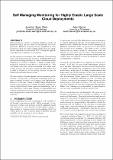Files in this item
Self managing monitoring for highly elastic large scale Cloud deployments
Item metadata
| dc.contributor.author | Ward, Jonathan Stuart | |
| dc.contributor.author | Barker, Adam David | |
| dc.date.accessioned | 2015-06-11T10:10:11Z | |
| dc.date.available | 2015-06-11T10:10:11Z | |
| dc.date.issued | 2014-06-23 | |
| dc.identifier | 165452806 | |
| dc.identifier | f9a1fa50-0352-4fff-8cf3-001234408c7b | |
| dc.identifier | 84904668795 | |
| dc.identifier.citation | Ward , J S & Barker , A D 2014 , Self managing monitoring for highly elastic large scale Cloud deployments . in DIDC '14 Proceedings of the Sixth International Workshop on Data Intensive Distributed Computing . ACM , pp. 3-10 , The 6th International Workshop on Data-intensive Distributed Computing (DIDC'14) , Vancouver , Canada , 23/06/14 . https://doi.org/10.1145/2608020.2608022 | en |
| dc.identifier.citation | workshop | en |
| dc.identifier.isbn | 9781450329132 | |
| dc.identifier.uri | https://hdl.handle.net/10023/6806 | |
| dc.description.abstract | Infrastructure as a Service computing exhibits a number of properties, which are not found in conventional server deployments. Elasticity is among the most significant of these properties which has wide reaching implications for applications deployed in cloud hosted VMs. Among the applications affected by elasticity is monitoring. In this paper we investigate the challenges of monitoring large cloud deployments and how these challenges differ from previous monitoring problems. In order to meet these unique challenges we propose Varanus, a highly scalable monitoring tool resistant to the effects of rapid elasticity. This tool breaks with many of the conventions of previous monitoring systems and leverages a multi-tier P2P architecture in order to achieve in situ monitoring without the need for dedicated monitoring infrastructure. We then evaluate Varanus against current monitoring architectures. We find that conventional monitoring tools perform acceptably for small, non changing cloud deployments. However in the case of large or highly elastic deployments current tools perform unacceptably incurring increased latencies, high load and slowed operation necessitating that a new, alternative tool be used. Further, we demonstrate that Varanus maintains low latency and low resource monitoring state propagation at scale and during during periods of high elasticity. | |
| dc.format.extent | 8 | |
| dc.format.extent | 557726 | |
| dc.language.iso | eng | |
| dc.publisher | ACM | |
| dc.relation.ispartof | DIDC '14 Proceedings of the Sixth International Workshop on Data Intensive Distributed Computing | en |
| dc.rights | © Owner/Author | ACM 2104. This is the author's version of the work. It is posted here for your personal use. Not for redistribution. The definitive Version of Record was published in DIDC '14 Proceedings of the sixth international workshop on Data intensive distributed computing, http://dx.doi.org/10.1145/2608020.2608022 | en |
| dc.subject | QA75 Electronic computers. Computer science | en |
| dc.subject.lcc | QA75 | en |
| dc.title | Self managing monitoring for highly elastic large scale Cloud deployments | en |
| dc.type | Conference item | en |
| dc.contributor.sponsor | The Royal Society | en |
| dc.contributor.sponsor | EPSRC | en |
| dc.contributor.institution | University of St Andrews.School of Computer Science | en |
| dc.identifier.doi | 10.1145/2608020.2608022 | |
| dc.identifier.url | http://www.fatih.edu.tr/~esma.yildirim/DIDC2014-workshop/home.html | en |
| dc.identifier.grantnumber | en | |
| dc.identifier.grantnumber | EP/K015745/1 | en |
This item appears in the following Collection(s)
Items in the St Andrews Research Repository are protected by copyright, with all rights reserved, unless otherwise indicated.

